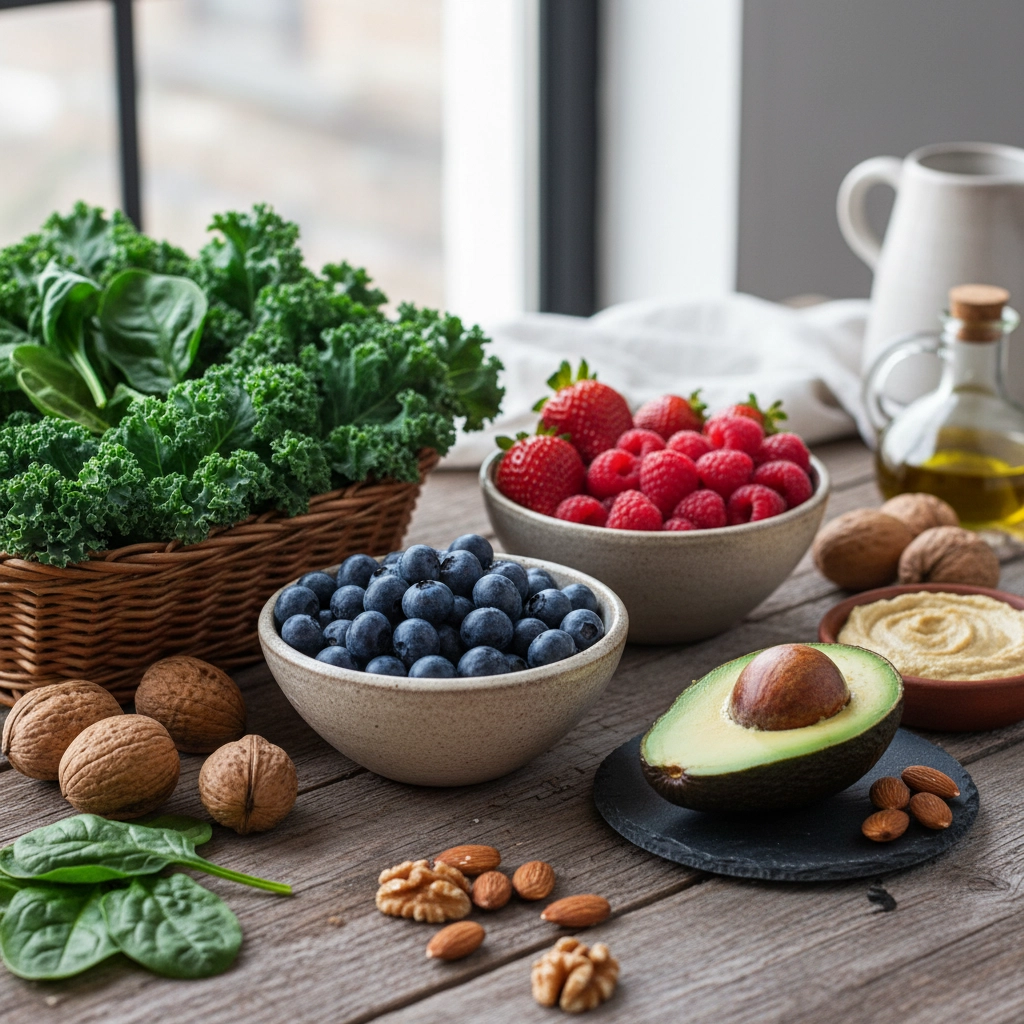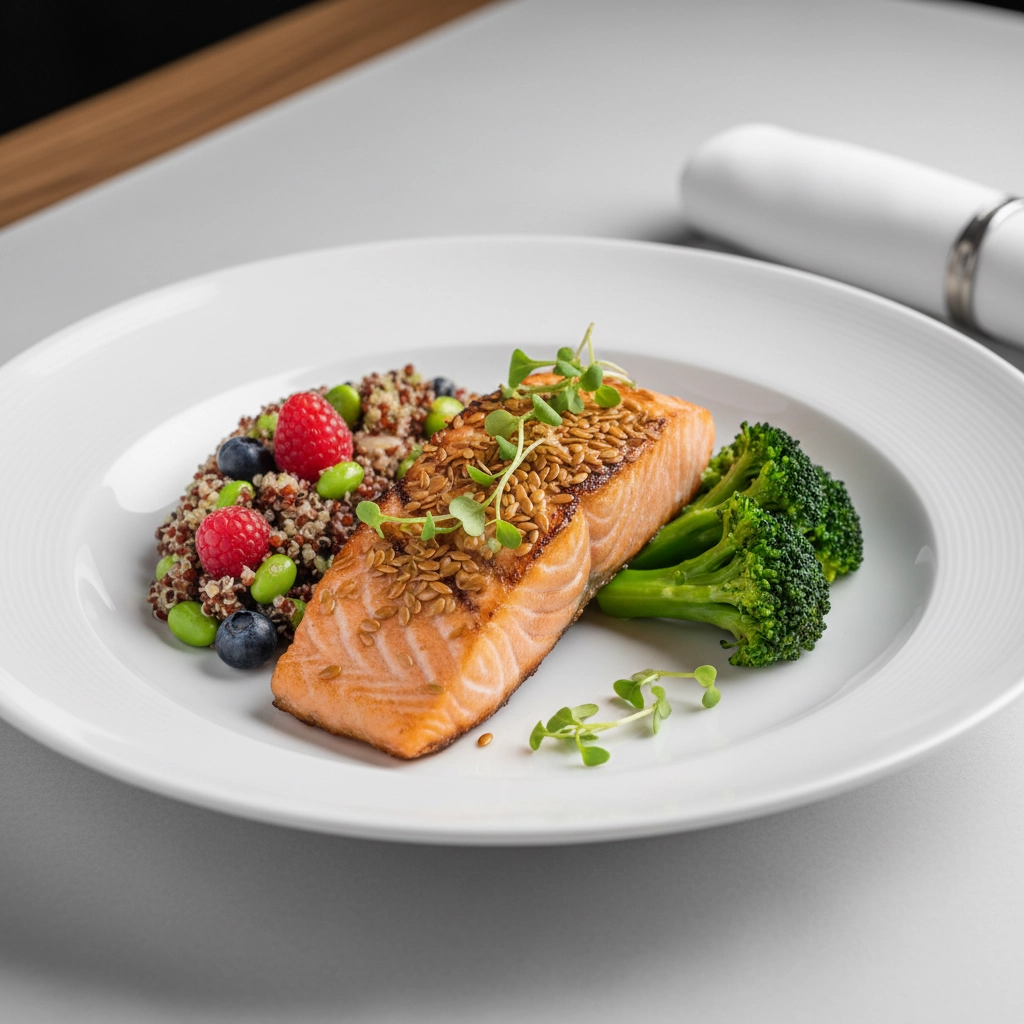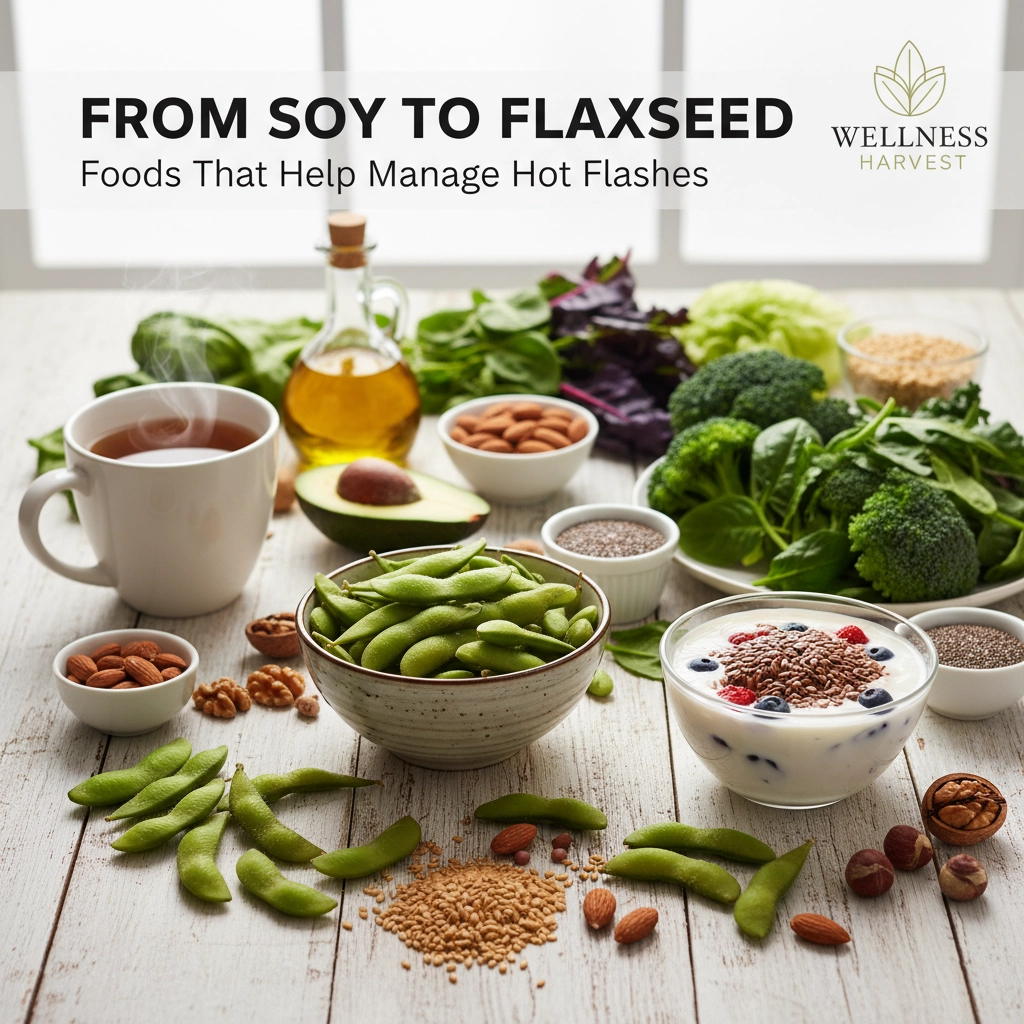There's something disorienting about the sudden surge of heat that seems to rise from nowhere. It starts in the chest, spreads to the face, and lingers long after it should have passed. Hot flashes, the signature symptom of menopause, arrive without warning and often leave women searching for relief in the aisles of grocery stores before they ever reach for medical care.
For decades, women have turned to nutrition first: to seeds, roots, and greens: in an effort to soothe what feels like a betrayal from within. The food and beverage industry has responded with an increasing array of functional foods, from soy-enriched products to flaxseed-fortified options, each holding its place in both folklore and, more recently, in science. These dietary strategies represent a growing segment of the food and beverage market, as consumers seek natural solutions for hormonal health. Today, many women benefit most from a layered care approach—nutrition as the base, estrogen patches when appropriate, and medical guidance to personalize the plan.
The Food and Nutrition Connection
At the heart of most menopausal symptoms is one consistent truth: estrogen is declining. This hormone, which once stabilized everything from mood to energy levels, no longer flows with the same rhythm. The result is a cascade of imbalances: hot flashes, night sweats, sleep disruption, and energy fluctuations that impact daily life and dining experiences.
The food and beverage industry has recognized this opportunity, developing products rich in plant-based estrogens: called phytoestrogens: that offer some relief by gently binding to estrogen receptors. Soy and flaxseed lead this category, with soy containing isoflavones while flaxseed offers lignans. Both mimic estrogen in the body, though at a much weaker level than traditional hormone therapy.

Studies suggest these foods may reduce the frequency or intensity of hot flashes in some women. For food service industry professionals and beverage industry leaders, this represents a significant market opportunity as more consumers seek functional foods that support hormonal health.
Soy: The Plant-Based Powerhouse
Soy products have emerged as the most researched option in the food and beverage management sector for hot flash relief. Restaurants and food service companies are increasingly incorporating soy-based menu items to appeal to health-conscious consumers navigating menopause.
The most beneficial soy products include:
- Organic tofu and tempeh – versatile proteins for menu innovation
- Soy milk and yogurt alternatives – popular in beverage industry offerings
- Edamame – trending appetizers in plant-based dining
- Miso and fermented soy products – umami-rich ingredients gaining popularity
Food and beverage companies have capitalized on soy's benefits by creating dedicated product lines. From soy-based protein powders to ready-to-drink beverages, the market continues expanding as research dispels previous concerns about soy safety. Recent clinical trials show that soy consumption not only supports hormonal balance but may offer protective benefits due to its antioxidant properties.
Flaxseed: The Trending Superfood
Flaxseed represents another powerful category in the functional food space, offering food and beverage directors multiple options for menu integration. These nutrient-dense seeds pack omega-3 fatty acids, lignans, and fiber into a versatile ingredient that's reshaping healthy meal options across the hospitality industry.

Clinical research demonstrates impressive results for flaxseed consumption, with one study showing a 41% decrease in hot flash frequency among women consuming flaxseed regularly. For food and beverage services, this translates to consumer demand for flaxseed-enhanced products.
Menu Innovation Opportunities:
- Ground flaxseed in smoothie bowls and protein drinks
- Flaxseed oil in salad dressings and finishing oils
- Flaxseed crackers and baked goods
- Breakfast cereals and oatmeal toppings enriched with flaxseed
Food and beverage companies are responding with innovative applications, from flaxseed milk alternatives to high-protein yogurt enhanced with ground flaxseed.
Building a Supportive Food Portfolio
Beyond soy and flaxseed, the food and beverage industry has identified numerous other ingredients that support hormonal health through various mechanisms. These foods represent significant opportunities for procurement directors and foodservice executives looking to meet growing demand for functional nutrition.
Cold-Water Fish and Omega-3s
Salmon, sardines, and other omega-3 rich fish provide anti-inflammatory compounds that may reduce hot flash intensity. Restaurants are featuring these prominently in heart-healthy menu sections, while beverage companies explore fish oil supplements and omega-3 enhanced drinks.
Antioxidant-Rich Berries
Strawberries, blueberries, and raspberries offer concentrated antioxidants that may help protect against hormonal fluctuations. The beverage industry has embraced these with antioxidant smoothies, berry-infused waters, and adaptogen drinks featuring these fruits.
Leafy Greens and Cruciferous Vegetables
Kale, spinach, broccoli, and Brussels sprouts provide essential nutrients supporting hormonal function. Food service industry trends show increased demand for vegetable-forward dishes and plant-based dining options featuring these ingredients.

Nuts, Seeds, and Healthy Fats
Beyond flaxseed, walnuts, almonds, chia seeds, and avocados provide healthy fats that support overall hormonal health. Food and beverage trends show growing popularity of nut-based milk alternatives and seed-enhanced products.
Food as Foundation: Industry Response
The role of nutrition in managing menopausal symptoms represents a significant market opportunity that food and beverage companies are increasingly addressing. Rather than positioning food as a complete solution, successful brands are marketing these products as foundational support for women's health.
Leading food and beverage companies are developing comprehensive product lines that combine multiple beneficial ingredients. From protein powders featuring both soy and flaxseed to functional beverages combining berries with adaptogens, the industry is creating synergistic formulations.
Key Market Trends:
- Increased demand for organic, non-GMO soy products
- Growth in flaxseed-enhanced baked goods and cereals
- Rising popularity of hormone-supporting functional beverages
- Menu innovation featuring phytoestrogen-rich ingredients
Food and beverage sustainability initiatives also align with this trend, as many of these hormone-supporting foods fit well within sustainable food brands and local food sourcing programs.
Estrogen Patches: A Modern Approach
Among the many ways to deliver estrogen, transdermal patches offer a combination of efficacy, safety, and convenience that makes them an ideal option for many women. Unlike oral estrogen, which must pass through the liver, patches deliver estradiol directly into the bloodstream via the skin. This bypasses first-pass metabolism and helps maintain more stable hormone levels.
For women concerned about blood clots, blood pressure, or liver strain, this distinction matters: clinical guidance notes that transdermal estradiol is associated with a lower risk of venous thromboembolism than oral forms. Organizations such as ACOG and The Menopause Society acknowledge the favorable risk profile of transdermal routes when appropriately prescribed.
Patches are discreet, easy to use, and—when prescribed via telehealth—accessible from the privacy of home. Increasingly, women use licensed platforms to obtain prescriptions and buy patches online, not out of convenience alone, but because traditional healthcare systems have left gaps in timely menopause care.
These patches aren’t synthetic replicas. Most commercial estradiol patches are bioidentical, meaning they match the molecular structure of the estrogen a woman’s body once produced naturally. That compatibility often leads to fewer side effects and a smoother transition.
Practical considerations for layered care (nutrition + patches + medical guidance):
- Dosing and formats: options range from low-dose to standard-dose patches changed once or twice weekly; clinicians can titrate to symptom control.
- Endometrial protection: individuals with a uterus typically require a progestogen alongside estrogen to protect the uterine lining; this can be delivered orally, transdermally, or via an IUD per clinician guidance.
- Skin care: rotate application sites to reduce irritation, apply to clean, dry skin, and avoid cutting patches.
- Safety and eligibility: hormone therapy isn’t right for everyone; history of estrogen-sensitive cancers, active thromboembolic disease, or uncontrolled hypertension warrant specialist oversight.
For teams across the food and beverage industry, better symptom control can translate to improved sleep, steadier energy on shift, and stronger guest experiences. In practice, patches pair well with a nutrition-first program as part of layered care: food as foundation, clinical support when needed, and ongoing medical guidance.
Beyond the Flash: Long-Term Benefits
Hot flashes are what bring most women to treatment. But estrogen therapy offers broader protective effects, including:
- Bone density support, helping to prevent osteoporosis
- Reduced risk of colorectal cancer
- Improved skin texture and hydration
- Better vaginal and urinary health
- Cardiovascular support when started early
This isn’t about vanity. It’s about vitality and supporting the body’s overall health during and after menopause.
The Layered Nutrition Strategy
Food and beverage management professionals are recognizing that effective hormonal support requires a comprehensive approach. This "layered strategy" combines multiple food categories and preparation methods to maximize benefits:
1. Tracking and Personalization
Advanced food service technology now allows for personalized nutrition tracking, helping consumers identify which foods most effectively support their individual needs.
2. Foundational Support Through Food
Restaurants and food companies are creating menus and products that emphasize:
- Hydration through functional beverages
- Blood sugar stability through whole grains and balanced meals
- Anti-inflammatory ingredients in prepared foods
- Sleep-supporting nutrients in evening menu options
3. Professional Guidance Integration
Forward-thinking hospitality industry leaders are partnering with nutritionists and wellness professionals to provide comprehensive support beyond just serving beneficial foods.

Long-Term Health Benefits and Market Opportunities
The benefits of hormone-supporting foods extend far beyond hot flash management, creating sustained market opportunities for food and beverage companies. Research indicates that diets rich in phytoestrogens and anti-inflammatory compounds may support:
- Bone health – driving demand for calcium-rich and vitamin D enhanced foods
- Cardiovascular wellness – increasing interest in heart-healthy menu options
- Cognitive function – spurring development of brain-supporting functional foods
- Skin and tissue health – creating opportunities in beauty-from-within food products
- Overall vitality and energy – supporting the broader wellness food trend
Industry Innovation and Future Outlook
The intersection of women's health and functional foods represents a rapidly growing segment within the food and beverage industry. Restaurant marketing increasingly features hormone-supporting ingredients, while beverage industry leaders develop specialized products for this demographic.
Food industry awards now recognize innovation in functional foods, highlighting companies that successfully combine taste, nutrition, and health benefits. Hospitality technology is enabling better tracking of customer preferences for these specialized dietary needs.
As food safety trends continue emphasizing transparency and clean labels, consumers are gravitating toward recognizable, whole food ingredients like soy and flaxseed rather than synthetic alternatives. This trend supports sustainable food brands and aligns with local food sourcing initiatives.
The growing market for hormone-supporting foods demonstrates that when nutrition meets innovation, both consumer health and business success can flourish. For food and beverage professionals, understanding and serving this market represents not just an opportunity to build profitable product lines, but to genuinely improve the quality of life for millions of women navigating this natural life transition.
By focusing on whole foods, transparent sourcing, and comprehensive nutrition education, the food and beverage industry can continue leading the way in functional nutrition that truly makes a difference in people's daily lives.
Written by Michael Politz, Author of Guide to Restaurant Success: The Proven Process for Starting Any Restaurant Business From Scratch to Success (ISBN: 978-1-119-66896-1), Founder of Food & Beverage Magazine, the leading online magazine and resource in the industry. Designer of the Bluetooth logo and recognized in Entrepreneur Magazine's "Top 40 Under 40" for founding American Wholesale Floral. Politz is also the founder of the Proof Awards and the CPG Awards and a partner in numerous consumer brands across the food and beverage sector.








